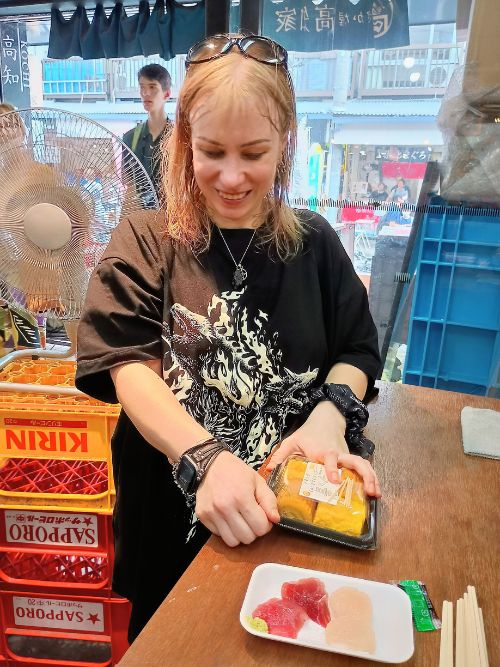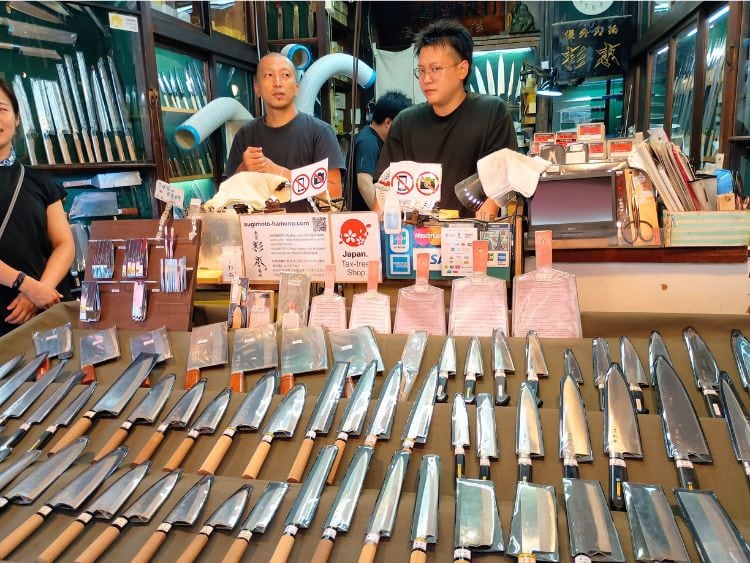
Go World Travel is reader-supported and may earn a commission from purchases made through links in this piece.
It has been said that every traveler should explore Japan at least once in a lifetime. I hate to admit it, but somehow, Japan never showed up on my destination radar until after I had visited 120 other countries. When I finally made the trip, I couldn’t get enough of it.
Starting in Tokyo
The majority of first-time visitors to Japan start their adventure in Tokyo, as we did. Exposure to a conservative culture whose traditions and customs, steeped in thousands of years of history, unfold as completely different from anywhere else in the world.
Tokyo pulsates with excitement and offers a magical blend of ancient sites that command respect and reverence and modern neighborhoods that are electrified by neon lights and edgy technology.
No matter what the traveler includes on ‘must see’ itineraries, one thing is for sure: everyone needs to eat. Traditional Japanese food, known as washoku, with its tantalizing ingredients, strange, pickled vegetables, exotic sushi, soups, and sashimi requires at least a sketchy prefix of what to expect.
Culinary Adventures in Japan

Before joining our small group tour, my husband and I, our adult son and his wife landed at Narita Airport two days early to learn about and taste basic, Japanese culinary delights. A myriad of Foodie Tour companies exist in Tokyo, but we booked City Unscripted beforehand and personalized our private tour with a guide. We lucked out on every aspect.
Our hotel, Vista Tokyo Tsukiji was located within a five-minute walk from the renowned Tsukiji Outer Market. Our guide, Chiara Miske, a funky, fun-loving transplant from Berlin to Tokyo 14 years ago, knew Japanese food, the local lingo, the merchants, Japanese dining etiquette and she spoke perfect English; an ideal match for our family.
The Tsukiji Fish Market

The Tsukiji Fish Market, located in the neighborhood of Chuo City since 1935, once had the distinction of being the largest seafood market in the world. Constructed on reclaimed land from Tokyo Bay after the Great Kanto earthquake of 1923, the Outer Market serves as the retail subdivision, while the wholesale section with its lively 5am tuna auction for fishermen to sell their daily catch, moved a few blocks to Toyosi Market in 2018.
Best Tips & Tools to Plan Your Trip
Open from 5am – 2pm, closed Wednesdays and Sundays, the Outer Market provides a labyrinth of narrow streets, vendors lining both sides, where chefs from local restaurants navigate through the maze to shop for the freshest ingredients.
The environment wets the novice visitor’s appetite for the unique, Japanese culinary experiences to come. Mornings, when the streets awaken with lively activity and the food choices are plentiful and fresh, remain the favorite time to wander around.
Street Food Delights

With taste buds primed, we arrived for our fun, street-foodie event under Chiara’s watchful eye at 9am. Since we had pre-paid a set amount, the company allotted our guide a generous budget to purchase food we wanted to sample and strange treats she knew we’d encounter at meals.
As we meandered through the crowded market streets, we saw Japanese customers standing at high-rise tables in front of food stalls, eating raw fish, seafood, or vegetable tempura, and drinking sake or beer for breakfast.
My husband, Ernie, joined the throng with a fresh oyster, the size of his hand, as he slurped it and let the succulent mollusk slide down his throat. Chiara guided us to a stand that she knew sold only top-grade, A-5 Wagyu beef on a skewer, and after the vendor grilled it to perfection, my son smiled after every bite.
Savoring Unique Flavors

I couldn’t imagine trying to maneuver this overwhelming scene without the wisdom and information of a knowledgeable guide. Chiara introduced us to sashimi– raw fish- tuna, red snapper and salmon, and nigiri– Japanese style sushi with thinly sliced, oblong pieces of raw shellfish, hand-pressed over white rice.
We feasted on yomagi mochi– sticky rice cakes filled with red bean paste, tamagoyaki-a Japanese omelet, with folded layers of seasoned scrambled eggs, and Tako tamago– small octopus wrapped around quail eggs.
We learned about karebushi– dried bonito fish flakes; bonitos are classified as medium predatory fish in the same family as tuna and mackerel. The flakes are used to make dashi– a clear fish stock used as an essential ingredient in Japanese cuisine. We sampled one of the many craft beers for which Japanese have a thirst and drank shots of sake before 10am.
Due to the volcanic soil, the enormous size of fruits and vegetables shocked the senses; peaches the size of large grapefruits, gigantic cucumbers and beets. We bought bags of dried seaweed sprinkled with sesame, rice cake snacks and wasabi coated beans to munch on in Japan and to bring home.
Markets in Japan Hidden Treasures

Specialty shops selling tea sets, pottery and the centuries-old skill of Japanese cutlery and exquisite knives popped up, but we could have never found the stalls without Chiara’s infinite map of the whole area in her head. My son and his wife found sharp steel treasures in a knife shop that has been at this same location for over 100 years.
Evening Indulgence
Fine dining restaurants, some hidden away in small alleyways, dotted the marketplace. Ernie and I made a mental note of one of the unique eateries that specialized in Wagyu beef and returned there that night for dinner.
The streets were deserted, dark and spooky. The vibrancy of daytime activities felt like a ghostly memory, but the Wagyu beef melted in our mouths like butter. Despite only a few footsteps heard from other people going to dinner, we felt not a moment of fear.
An aura of safety permeates wherever you go in Japan – in Tokyo, at night, walking, on the subway, in a darkened alley- it is a peaceful, unfamiliar feeling.
Transitioning to Kyoto Markets

By the time we arrived in Kyoto 14 days later, miso soup, pickled broccoli and sashimi had settled into my diet as normal mealtime staples. We cooked our own hotpot sukiyaki at the table; vegetables, tofu, broth and beef or chicken simmered on top of a burning candle or steno.
Proper chopstick etiquette no longer eluded me and sake was becoming my favorite drink. Exploring markets in Japan gradually morphed into an exciting and independent activity. Chiara had taught us well.
Filled with eagerness and a hint of sad reality we headed out from our final hotel, Vista Premio Kyoto, to take-in the sights and smells of foods unique to Kyoto; the last Japanese market experience –at least this trip! Off to explore Nishiki Market, a five-minute walk away.
Nishiki Market, Kawara Machi, Kyoto
Originally a fish market dating back to 1310, Nishiki Market has remained a five-block street, crammed with 130 vendors offering everything needed for Japanese cooking for 400 years. Referred to as ‘Kyoto’s Kitchen,’ it is the go-to place for locals, chefs, and tourists alike. T
he entire length of the shopping area is covered with a slice of rainbow-colored glass, and vibrant flags representing Japanese cuisine hang from the ceiling. It feels like a carnival; vendors offering samples of their wares, people browsing and Japanese grabbing bites on their way to work. Rather than feverish chaos, the market merchants proceed with methodical calm. Like everything in Japan, respect for the food, for the environment, and for the customer prevails.
A Culinary Wonderland

Open from 9:30 am – 5 pm, the morning spins with robust activity as vendors prepare their offerings to display artistically in front of their stores. We visited tsukemono stalls which sold shebazuke of pickled cucumbers and eggplant. I tasted a huge Japanese pickle on a stick and found it so divine I needed to eat more than one.
We gravitated to the rows of fried tempura vegetables and grilled seafood, all skewered for easy eating onsite. Ernie grabbed a juicy, plump grilled crab leg on a stick and cherished every bite. We stopped to taste senbai- Japanese snacks made of rice, and then watched as vendors wearing knee-high rubber boots, sliced and fileted fresh catch fish to sell.
Flowers, sake gift sets, seasonings, fresh vegetables, strawberry topped rice cakes; it is a cornucopia of invigorating color for the eyes, sounds of vendor activity for the ears and tantalizing tastes for the mouth.
We loved this market so much, we ran back for one last look, on the morning we left for the airport. We toasted Japan and everything memorable about it with our final swig of sake.
Sayonara, Japan
Read More:
Author Bio: After a life-long profession of treating the mentally ill at a PA psychiatric hospital for 33 years, Carol retired to Lake Chapala, Mexico in 2006 with her husband,to pursue more positive passions. Her family thought that she too had ‘gone mad.’ Carol has taught English to Mexican adults and disadvantaged local children for the past 18 years. She writes for local, international, on-line and print publications. Using her adventures to over 120 countries, she has captured a niche in travel writing. A frequent contributor to El Ojo del Lago, the largest distribution English magazine in Mexico, she’s won several literary awards from that publication. Her psychiatric field work netted a contribution to the anthology, Tales from the Couch. Recently she has also been featured in two more anthologies, Insider’s Guide to the Best of Mexican Holidays, and Bravados, Life, Love and Living in Lake Chapala, Mexico, all available on amazon.com.
- Discover Claremont, California Along Historic Route 66 - December 6, 2024
- Three Sites to Soothe the Soul in Kyoto, Japan - December 5, 2024
- 13 Essential Tips For Women Traveling in Morocco - December 4, 2024


